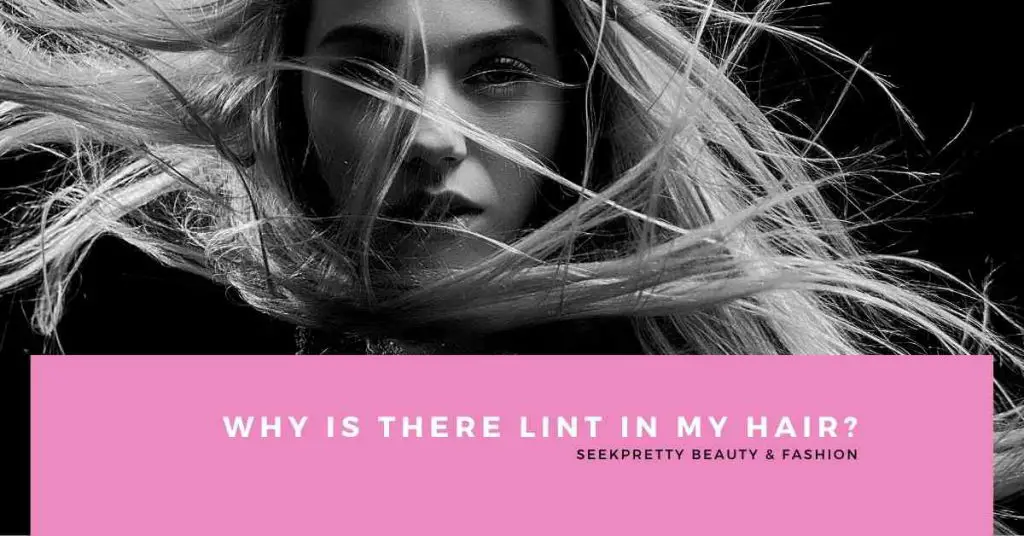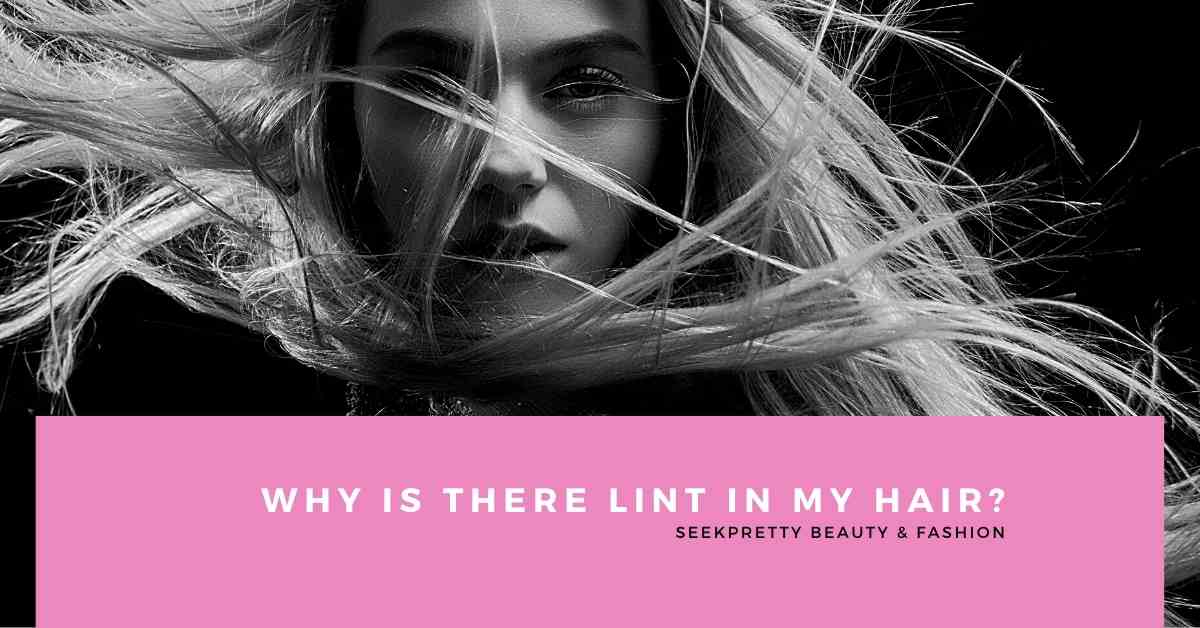We all know what it feels like to see lint in our hair and on our brushes, but why is lint there? There is lint in your hair for a number of different reasons. The main reason why you see lint in your hair is because dust, oil and fabric particles break down and get stuck in your hair. That’s not the only reason though. If you want to get lint out of your hairbrush then click to view our article showing you exactly how.
Let’s look a little closer and find out more about the lint we all want to see less of in our hair. I want to show you what lint is made from, where it comes from, how it affects our hair and I’ll suggest a few ways you can get rid of some of it.

Contents
What is lint?
Often dust, debris, and other particles in the environment combine and can get attached to your scalp, hair, or roots. This combination of particles is called lint. Lint sometimes presents itself in the form of a fabric that is a wool-like or a cotton thread-like material.
Where does lint come from?
Our hair carries naturally producing oil and sebum within them that act as adhesive for lint to be stuck on the scalp. Sebum is an oil that helps moisturise our scalp and is the reason our hairs become greasy between washes. It might make our hair look darker and greasy but it’s doing an important job protecting hair follicles and our scalp.
Certain hair types are more susceptible to lint. People with curly or dry hair tend to face lint problems more frequently. Similarly, dry hair makes hair prone to friction damage due to the lack of moisture. Hence, they become magnets for dust and other environmental debris.
Too much dust and debris ultimately result in lint forming in our hair. So, if you’re asking, why is there a lint in my hair? Get ready for a number of different reasons.
Why is there lint in my hair?
There is lint in your hair because dust, oils, debris, fabric materials and other particles breakdown and get caught in your hairs. These materials get stuck in your hair when you lie down on a certain fabric or naturally throughout the day from the environment, your own sebum production and other fabrics that come into contact with your hair.
As mentioned above, the key factor that makes you susceptible to lint in your hair is your hair type. Since the hairs in wavy and curly hair are tangled and there is an abundance of conditioner residue and sebum in the hair, they are very susceptible to lint.
Hair also has a quality of static attraction, which means that it can attract external materials. That’s one of the reasons why you can end up with cloth particles in your hair from your pillow, blanket, or clothes. Cloth debris is one of the main contributing factors towards lint formation in the hair.
Another major reason for the presence of lint in our hair is due to broken ends of our hair. These split ends can cause lint to attach to those split ends and get stuck. It’ll make your hair fuzzier and can also give you an itchy scalp. A lot of people tend to run their hands through their hair a lot. It’s a natural habit for some people, while others might do it when they’re feeling nervous or anxious.
Not only does that make your hair prone to breakage our hands also carry dust particles and other forms of micro material. You can pass them onto your hair from your hands by touching or running your finger through your hair regularly. This may surprise you, as most people know oiling hair is a healthy practice. However, walking out into the open with oiled hair is a major reason for the presence of lint in the hair.
How does lint affect your hair?
Lint does not affect our hair as severely as dandruff or lice do. However, it does cause an itchy scalp that can be annoying. At certain times excessive scratching can lead to injuries on the scalp. On curly and dry hair, it becomes very apparent to the naked eye, which may not look good on the hair. Hence, it is important to take care of your hair and avoid anything that might make them more prone to lint formation.
What colour is hair lint?
Lint in your can appear in lots of different colours. If cotton, wool and clothing fabric particles build up in your hair they can appear the same colours as the fabrics. I most often find the lint in my hair and the lint I clean from my hairbrush is coloured grey or white and mostly made up of hair and skin particles, sebum and dust. Sometimes colourful pieces of cotton thread get caught in my hair and small pieces of wool fluff.
How to get rid of lint in your hair
So, now you know what Lint is and if you are experiencing an itchy scalp or have so much lint that it’s becoming visible, then you might want to think about getting rid of some of it. I recently wrote about how to clean your hairbrush and remove the lint.
Removing these particles and hairs from your brush can help a lot in keeping those particles out of your hair every time you brush your hair. There are a few ways you can try to reduce hair lint. One way is by sleeping with a hair cap on or changing the type of pillows and bedding you sleep on. Doing this will help stop the fabric materials from ending up stuck in your hair.
Cotton hates and fuzzy scarfs are notorious for shedding fabrics into your hair, so avoiding wearing these materials around your neck and head often will stop cotton, wool and other clothing fabrics getting stuck in your hair. Instead, you can wear silk or satin materials which are much better for your hair.
Wash your hair regularly and be sure to remove shampoo and conditioner from your scalp and the roots of your hair as best as possible. Not rinsing your hair thoroughly can lead to dandruff and lint on your scalp and greasy hair is full of sebum oils.
Try not to spray your hair with hair spray or use other hair styling products frequently. Hair sprays cause grease, oil and other chemicals to build up in your hair. You could also consider using the Hair Envy essential oil or another hair care product to help reduce lint in your hair.
Tips for Preventing lint in your hair
- Always wash and rinse your hair thoroughly. Not rinsing your hair properly is the number one reason you are likely to see more lint appear in your hair and getting stuck on your hairbrush.
- Use less hairstyling products. hairstyling products leave residue on your hair that leads to grease and a build up of lint because its difficult to wash it off fully.
Do splint ends cause more lint in your hair?
Yes, split ends can cause more lint in your hair. Split ends mean that you have more broken strands of hair. Hair is breaking off and small pieces can clump together and cause what appear to be dust and white fluff in your hair. The scraggly shape of split ends is really good at catching dust, grease and other particles that cause lint. Try to cut off any split ends as soon as you can and take good care of your hair and condition it well so you don’t have so many split ends.
What is white fluff and dust in your hair?
White fluff in your hair is most likely lint. Dust, debris, sebum, dead skin cells, matted hair follicles and dry residue from your hair care products and unwashed shampoo clog together and can look like white fluff. You might also get white fluff in your hair from the clothing you wear, especially if you wear a wooly winter hat.
Does lint cause knots in your hair
Lint can cause knots in your hair because when you have lint in your hair it makes it more difficult to thoroughly brush out all the knows in your hair. Not washing, taking care of your hair, cutting split ends and bushing regularly are the main causes of knots in your hair and can also lead to more lint getting stuck. Knots can cause lint to build up and lint can make knots more difficult to brush out.

